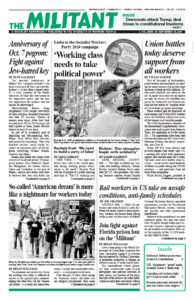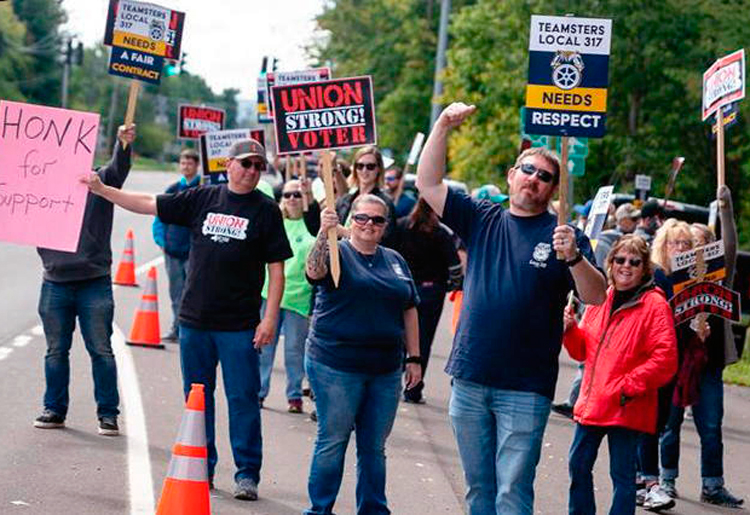The economic and social crisis facing the working class today is reflected in articles in the capitalist press acknowledging that what they call the “American dream” — a steady job, home ownership, a family and comfortable retirement — is increasingly out of reach.
Over the past 12 years, those saying the “American dream” still holds true has dropped precipitously from more than 50% to about 30% today, an Aug. 29 Wall Street Journal article reported. And that percentage declined more in the working class.
“While around 90% of children born in 1940 were ultimately better off than their parents,” the Journal said, “only around half of those born in the 1980s were able to say the same.” And this figure continues to tumble.
The main consequence of the squeeze on workers’ living standards is not a decline in myths about the “American dream.” It’s that today workers are in a mood to fight. More are involved in strikes to try to reverse years of the bosses’ assaults on wages and working conditions.
Nearly half of young adults aged 18 to 29 still live with their parents — the highest in more than 70 years — because high mortgages and rents prevent many from moving out and raising a family in the wealthiest capitalist nation in the world.
Overall prices are up 20% over the past four years and are not going back down. A number of essentials have risen even more: eggs and sugar are up 40%; bread, 46%; roast beef, 44%; and car insurance and repair, 47%, to name a few.
To cover such price hikes, working people have put more of their purchases on credit cards, which require annual interest rates of more than 20% on unpaid balances. As a result, delinquencies on credit card debt rose sharply over the past year — by more than 10% — to the highest level since 2012.
This underscores the fact that life in the U.S. is class-divided. While working people are finding it more difficult to make ends meet, the capitalist rulers and the upper middle class aren’t impacted much. Many are becoming wealthier off stock investments and their only concern is workers rocking the boat.
Declining job openings, wages
“Bosses Are Finding Ways to Pay Workers Less,” headlined another Journal article. The biggest drop was in retail, where average wages for new hires is down a full 55.9%. In agriculture it’s down 24.5% and manufacturing, 17.3%. This comes on top of a 3.9% decline in all workers’ average wages over the past three and a half years.
Tom Locke, the franchise owner of 56 McDonald’s in the Midwest, told the Journal that he starts workers at $13 an hour. He says he’s constantly asking managers if they can cut this to an even more measly $12.
Job openings fell to the lowest level in more than three years in July. The government figures on job growth for June and July were revised down by 86,000, on top of the 818,000 drop for the past year ending in March. The number of workers forced to work part time but who want full time jobs is up to 4.8 million, a rise of 600,000 since mid-2023.
Layoffs also rose in July, to 1.8 million, the highest level since March 2023. With a growing number of companies reluctant to hire new workers, bosses are driving to get those on the job to produce more in less time, increasing the threat to workers’ life and limb.
With an eye on the 2024 election, the Federal Reserve claims it’ll achieve a “soft landing” instead of a recession by manipulating interest rates. But its monetary maneuvers have little impact on the reality that working people face: higher prices, lower wages and benefits and steadily rising unemployment.
“The Fed welcomes a ‘soft landing’ even if many Americans don’t feel like cheering,” the Associated Press admitted. They point to slowing manufacturing and a drop of more than 8% in the number of housing units under construction since the start of this year.
Average house prices are now almost 38% higher than in January 2021. Monthly mortgage payments on a median-priced home are up to $3,000. That’s 50% higher than 2021.
The pace of apartment building construction has slowed down 41% over the last two years. Despite a dire need for low-cost rentals, most of the apartments being built are for upper-middle-class households who can afford the skyrocketing rents.
Sensing a huge profits bonanza, giant multibillion-dollar investment firms like KKR and Blackstone are buying up thousands of apartment buildings with plans to boost what are already high monthly rents.
For working people, changing these conditions depends on the class struggle — on joining together to fight the bosses’ attacks, on strengthening our unions and on organizing our own political party, a party of labor.


